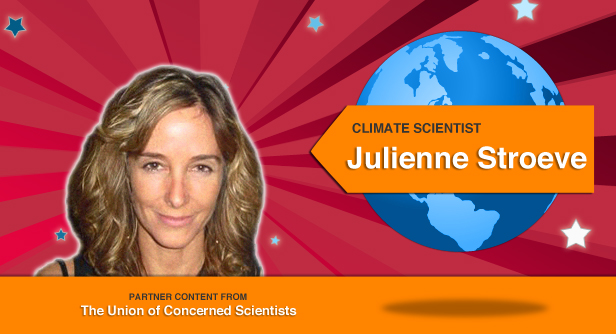You’ve probably seen pictures of stranded polar bears and heard that global warming is causing the melting of Arctic sea ice — that is, floating ice formed from freezing ocean surface water. But you may imagine, as most people do, that this distant phenomenon is unfolding gradually over a centuries-long time frame.
Julienne Stroeve, a climate scientist at the National Snow and Ice Data Center in Boulder, Colo., has compiled detailed measurements that melt away any such misconceptions. Stroeve is closely monitoring the extent of Arctic sea ice, and her research shows that dramatic changes are occurring right now — far faster than most experts anticipated and with enormous consequences for the whole planet, not just the Arctic region.

For instance, during the warmest part of 2010, the total amount of Arctic sea ice — the so-called “seasonal minimum” — was the third-smallest ever recorded. The smallest and second-smallest seasonal minimums were measured in 2007 and 2008, respectively. Natural variability, including factors like cloud cover, can easily explain differences in melting from year to year, Stroeve notes. But the big news is that the smallest amounts of Arctic sea ice ever measured have all occurred in recent years. “Basically, ever since 2002, we’ve had one pronounced record minimum after another,” she says. “The data all point to a strong warming signal.”
Stroeve explains that highly reliable data on the extent of Arctic sea ice has been collected since 1978. From then until now, she has found clear evidence of a 30-year melting trend, which, she says, “cannot be easily explained away by natural variability.” But her work is even more notable for its findings about the speed of the change. Over this same 30 years, a relatively brief period, Stroeve has found that some 40 percent of the region’s summer (or more precisely, September) ice has melted.
The fast pace of melting is seen even more dramatically, she explains, when one considers the age of the Arctic ice. Many parts of the Arctic Ocean freeze each year during the coldest months. But only ice that lasts throughout the year gradually becomes thicker over the course of consecutive seasons. “In the 1980s, the Arctic contained roughly 386,000 square miles of ice that was determined to be at least five years old,” she says. Now, “at the end of the melt season in September, only 22,000 square miles of such older, thicker ice remains.” In other words, the region has already lost more than 97 percent of the thicker year-round ice that existed just three decades ago. As she explains, “all the climatic processes seem to be pushing rapidly toward a seasonally ice-free Arctic Ocean.”
Stroeve says that initially she was as surprised by the data as anyone else. “I didn’t think global warming was even happening in the early 1990s when I began this work,” she says. Back then, some climate models were projecting that carbon emissions would lead to a pronounced warming trend at the poles. But Stroeve was always more interested in actual measurements than in climate modeling. “I think I was lured into studying the poles by the prospect of adventurous fieldwork in Greenland or the Alps,” she says with a laugh.
The daughter of an aerospace engineer, Stroeve had always exhibited a strong aptitude for math and science and an adventuresome spirit. From childhood through her high school years, her dream was to be an astronaut, she says, and she might have continued on that track if she hadn’t realized that her susceptibility to motion sickness was a serious impediment to working in space.
Her love of adventure continues in her work today, in which she makes regular research trips to the Arctic and Greenland to measure ice thickness and other snow and ice measurements. It might not be space travel, but Stroeve says her fieldwork has been as exciting as she could have hoped. “When I first visited Greenland, it was the most stunning landscape I had ever seen,” she says.
Along with her research in the polar regions, much of the data Stroeve analyzes comes from satellites that detect passive microwave radiation. As she explains, the higher brightness of ice in the microwave part of the spectrum can be seen by satellites even through cloud cover. “In the often-cloudy polar regions, that makes it an incredibly useful tool, providing data in which we have a high degree of confidence,” she says. These detailed satellite measurements of Arctic sea ice led Stroeve to shed her initial doubts about global warming. “My views changed as I studied the emerging data,” she says. “With record low sea-ice extents year after year, it became clear that a significant warming trend was underway.”
Looking closely at the data, Stroeve realized that a phenomenon called Arctic amplification, a form of positive feedback, is accelerating the warming trend, causing it to occur many years sooner than most climate models had projected. Arctic amplification occurs primarily because water absorbs far more heat than ice does. On average, Stroeve explains, water absorbs almost 93 percent of all the incoming solar radiation, whereas the white surface of snow-covered ice reflects about 80 percent of incoming solar radiation back into space.
As more and more of the Arctic Ocean sea ice melts over the summer months, it hastens further warming, Stroeve explains. She and her colleagues at the National Snow and Ice Data Center have measured the effect, showing that in areas where summer ice has disappeared, local autumn air temperatures have been more than 5 degrees F higher than the long-term average.
The potential of such feedbacks to cause abrupt climate change as the Arctic Ocean becomes nearly ice-free in the warm season drew widespread attention to Stroeve’s work in 2007. In that record-breaking warm year, the Arctic Ocean lost more than one-quarter of its remaining ice. “Because new ice can’t get very thick in one season, it is more vulnerable to annual temperature changes, as we saw in 2007,” she says.
The possibility of sudden shifts in the region’s climate, and thus the planet’s climate, is the most frightening implication of her research, Stroeve says. The quick and volatile changes in Arctic sea ice remind us that the geological record contains clear evidence of abrupt climatic changes in the planet’s history. “We know that Arctic ice has historically helped keep the Northern Hemisphere cool,” Stroeve says. “Without it, given atmospheric circulation, the planet will certainly warm more quickly. But we don’t know enough about the system to fully project how swift the changes might turn out to be.”
The prospect of sudden climate change is certainly scary, Stroeve says. But she adds that, because the stakes are so high, her decision to study Arctic sea ice has proven a more exciting choice than she ever imagined. As she puts it, “Not a lot of people were looking at sea ice when I began my research. But especially after 2007, which took everyone by surprise, it has become something that climate scientists are intensely interested to know about.”
This is the 14th installment of America’s Climate Scientists: A series from the Union of Concerned Scientists. Click here to read all the climate scientist profiles.
The Union of Concerned Scientists is currently leading a campaign to elevate the voices of climate scientists and educate the public about the overwhelming scientific evidence for human-caused global warming. Learn how you can get involved at www.ucsusa.org/evidence.



